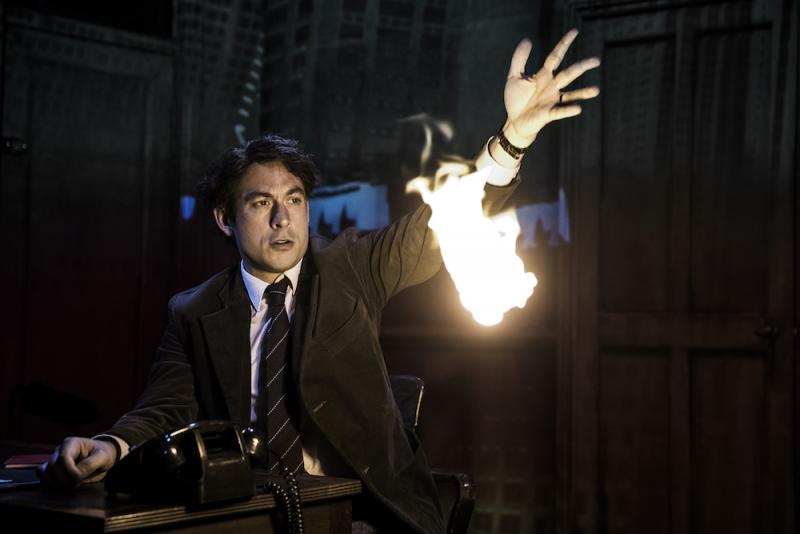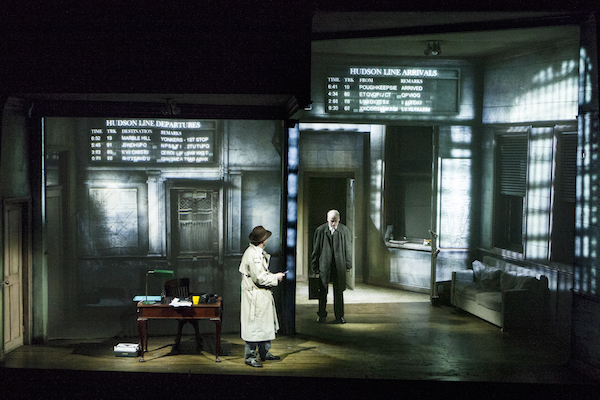City of Glass, Lyric Hammersmith review - ‘thrilling and enthralling Paul Auster adaptation’ | reviews, news & interviews
City of Glass, Lyric Hammersmith review - ‘thrilling and enthralling Paul Auster adaptation’
City of Glass, Lyric Hammersmith review - ‘thrilling and enthralling Paul Auster adaptation’
Masterpiece of writer's 'New York Trilogy' is visually amazing, intellectually satisfying on stage

Playwright Duncan Macmillan has had a good couple of years. In 2015, his play People, Places and Things was a big hit at the National Theatre, winning awards and transferring to the West End.
City of Glass, the first part of Auster’s New York Trilogy, was first published in 1985. It’s an enjoyable tricksy, postmodern novel in which Daniel Quinn, a detective-story writer, becomes a freelance investigator after answering a mysterious telephone call, in which a guy called Peter Stillman asks to speak to a private detective named Paul Auster. As Quinn becomes embroiled in a plot that resembles a hall of mirrors, he meets Stillman, then Stillman’s femme fatale wife Virginia, then Stillman’s crazy father and finally Auster himself. As Quinn loses his grip on reality, the city itself becomes fluid.
We are, argues Auster, alone in the universe, with no God and no Father Christmas
The narrative here follows the twists and turns of the original novel, with much of the storytelling taking the form of a voiceover. Macmillan is completely faithful to Auster’s passion for poststructuralist ideas about language: in this story, the older Stillman is obsessed with the origins of language – parables tell of how Adam used words in the Garden of Eden; of the Tower of Babel; and of the relationship between God and language. A gross story of a child held in solitary confinement in a darkened room is reminiscent of the case of Kaspar Hauser. A symbolic egg suggests the age-old question of what came first: chicken or egg?
Macmillan’s adaptation is directed by Leo Warner for 59 Productions, whose video work has contributed to plays staged by Katie Mitchell and Melly Still. This time, the effect is a stunning visual and verbal experience, with long passages of narrative illustrated with superb, often entrancing, video imagery. Projections, light changes, moments of stage magic and the use of two actors to play Quinn create a dizzy effect of plunging down the rabbit hole, as literary allusions chase philosophical ideas deep underground. Aesthetically beautiful in its coherence and toned-down palette, City of Glass is a terrific experience.  It’s not all cerebral and filmic, enjoyable as those aspects of the show undoubtedly are. By the end, as Quinn loses everything in his fanatical quest for the truth, the image of a naked man, alone in an uncaring world, is a powerful moment of human compassion and a reminder of our essential solitariness. Despite Stillman’s religious illusions, we are – argues Auster – alone in the universe, with no God and no Father Christmas. This perception is the emotional fuel behind the novel, and Macmillan transposes it brilliantly to the stage.
It’s not all cerebral and filmic, enjoyable as those aspects of the show undoubtedly are. By the end, as Quinn loses everything in his fanatical quest for the truth, the image of a naked man, alone in an uncaring world, is a powerful moment of human compassion and a reminder of our essential solitariness. Despite Stillman’s religious illusions, we are – argues Auster – alone in the universe, with no God and no Father Christmas. This perception is the emotional fuel behind the novel, and Macmillan transposes it brilliantly to the stage.
As the projections dazzle the eyes, with rooms bleaching into greyness, outside scenes invading inner spaces, hotel rooms turning into railway stations (pictured above), maps appearing on walls and skyscrapers rising from the floor, there’s a thoroughly exciting sense of innovative theatre here. If only this style of theatre was used more often! The main casualties are the actors, who become secondary except for a couple of outstanding episodes. But the ensemble – Vivienne Acheampong (Vivienne), Mark Edel-Hunt (Quinn), Chris New (Quinn) and Jack Tarlton (Stillmans) – are excellent, and the performers play several roles each. But what you remember most is the seedy set, designed by Jenny Melville, and the video work by Lysander Ashton, in a genuinely thrilling and enthralling evening.
rating
Explore topics
Share this article
The future of Arts Journalism
You can stop theartsdesk.com closing!
We urgently need financing to survive. Our fundraising drive has thus far raised £49,000 but we need to reach £100,000 or we will be forced to close. Please contribute here: https://gofund.me/c3f6033d
And if you can forward this information to anyone who might assist, we’d be grateful.

Subscribe to theartsdesk.com
Thank you for continuing to read our work on theartsdesk.com. For unlimited access to every article in its entirety, including our archive of more than 15,000 pieces, we're asking for £5 per month or £40 per year. We feel it's a very good deal, and hope you do too.
To take a subscription now simply click here.
And if you're looking for that extra gift for a friend or family member, why not treat them to a theartsdesk.com gift subscription?
more Theatre
 Troilus and Cressida, Globe Theatre review - a 'problem play' with added problems
Raucous and carnivalesque, but also ugly and incomprehensible
Troilus and Cressida, Globe Theatre review - a 'problem play' with added problems
Raucous and carnivalesque, but also ugly and incomprehensible
 Clarkston, Trafalgar Theatre review - two lads on a road to nowhere
Netflix star, Joe Locke, is the selling point of a production that needs one
Clarkston, Trafalgar Theatre review - two lads on a road to nowhere
Netflix star, Joe Locke, is the selling point of a production that needs one
 Ghost Stories, Peacock Theatre review - spirited staging but short on scares
Impressive spectacle saves an ageing show in an unsuitable venue
Ghost Stories, Peacock Theatre review - spirited staging but short on scares
Impressive spectacle saves an ageing show in an unsuitable venue
 Hamlet, National Theatre review - turning tragedy to comedy is no joke
Hiran Abeyeskera’s childlike prince falls flat in a mixed production
Hamlet, National Theatre review - turning tragedy to comedy is no joke
Hiran Abeyeskera’s childlike prince falls flat in a mixed production
 Rohtko, Barbican review - postmodern meditation on fake and authentic art is less than the sum of its parts
Łukasz Twarkowski's production dazzles without illuminating
Rohtko, Barbican review - postmodern meditation on fake and authentic art is less than the sum of its parts
Łukasz Twarkowski's production dazzles without illuminating
 Lee, Park Theatre review - Lee Krasner looks back on her life as an artist
Informative and interesting, the play's format limits its potential
Lee, Park Theatre review - Lee Krasner looks back on her life as an artist
Informative and interesting, the play's format limits its potential
 Measure for Measure, RSC, Stratford review - 'problem play' has no problem with relevance
Shakespeare, in this adaptation, is at his most perceptive
Measure for Measure, RSC, Stratford review - 'problem play' has no problem with relevance
Shakespeare, in this adaptation, is at his most perceptive
 The Importance of Being Earnest, Noël Coward Theatre review - dazzling and delightful queer fest
West End transfer of National Theatre hit stars Stephen Fry and Olly Alexander
The Importance of Being Earnest, Noël Coward Theatre review - dazzling and delightful queer fest
West End transfer of National Theatre hit stars Stephen Fry and Olly Alexander
 Get Down Tonight, Charing Cross Theatre review - glitz and hits from the 70s
If you love the songs of KC and the Sunshine Band, Please Do Go!
Get Down Tonight, Charing Cross Theatre review - glitz and hits from the 70s
If you love the songs of KC and the Sunshine Band, Please Do Go!
 Punch, Apollo Theatre review - powerful play about the strength of redemption
James Graham's play transfixes the audience at every stage
Punch, Apollo Theatre review - powerful play about the strength of redemption
James Graham's play transfixes the audience at every stage
 The Billionaire Inside Your Head, Hampstead Theatre review - a map of a man with OCD
Will Lord's promising debut burdens a fine cast with too much dialogue
The Billionaire Inside Your Head, Hampstead Theatre review - a map of a man with OCD
Will Lord's promising debut burdens a fine cast with too much dialogue

Add comment